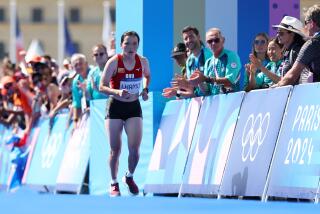SHE RIDES IN CYCLES : Cindi Staiger Had Miles and Miles to Go Before She Slept
- Share via
Just more than three weeks ago, Cindi Staiger’s days consisted of almost nothing but pedaling. Her nights, too, were filled with pedaling, not sleep.
In Utah, she rode smack through a thunderstorm, battling headwinds that were relieved only by crosswinds. In Colorado, she climbed to 11,307 feet, crossing the Rocky Mountains in freezing temperatures at Berthoud Pass. In Kansas, she outraced combines in 115-degree heat.
And in Washington, D.C., she was the first woman to cross the finish line.
Staiger, who lives in Long Beach, completed the 3,100-mile Race Across America from San Francisco to Washington in 12 days 3 hours 55 minutes, and was one of only three women to finish. In all, only 14 of the 43 riders who began the race finished, led by the men’s winner, Franz Spilauder of Austria, whose time of 9 days 7 hours 9 minutes set a record for the crossing.
Staiger, 36, isn’t spending much time on her bicycle these days, and it’s little wonder. She climbs on it for the photographers who come around, and she takes occasional short rides--that’s 25 to 50 miles, for her.
But it’s more a time to look at the scrapbook her nine-member crew kept for her, to thank those who helped sponsor her and to reflect on what she has accomplished.
Her progress toward winning one of the more grueling events in sports has been dramatic.
It has been only about two years since she rode her first century--a 100-mile ride.
She started last year’s Race Across America, but had to drop out at 1,134 miles--because her crew gave up at 800 miles.
This year was different. She carefully chose the support crew that would follow her in a van, urging her on and taking care of all the details to keep her going.
And she set out to win. Staiger, who works in electrical sales for a Rosemead agency, rode 500-600 miles a week in training for the race.
On the first day of the race, she rode 346 miles, earning the women’s leader jersey. She averaged more than 250 miles a day, and she kept the jersey every day.
As if the physical exertion of a cross-country race were not enough, these racers increase the toll on their bodies by largely forgoing sleep.
Staiger, like other riders, rode 20 or 21 hours a day. She would ride well into the night, stopping at 3 or 4 a.m., only to be back on the bike before dawn.
Such a lack of sleep often causes hallucinations, but Staiger said she experienced “just normal stuff”--a cactus by the side of the road would seem to be a person, for instance. But she depended on a diet of 8,500 to 10,000 calories a day to keep her going, and she believes she stayed remarkably alert.
And when she arrived in Washington a bit more than 3,100 miles and only two flat tires after starting from the Golden Gate Bridge, she said she felt “really tired, but I really felt quite healthy. I had no major difficulties physically going across.”
But the physical demands of the race are only part of it.
Staiger believes the race is “90% mental,” a claim that most cyclists would be hard-pressed to believe.
It is, no doubt, a lonely race. The riders separate on the first day, and even if they find themselves near each other on the route, they are only permitted to ride together for 15 minutes a day.
“The whole goal in this race is individual accomplishment,” Staiger said. “There’s no drafting allowed on another rider or on a vehicle.”
There is plenty of time--too much time--to think.
“You start daydreaming,” Staiger said. “I thought about a whole lot of things. A lot of times I just thought about the road. You think about it. You think about what you’re doing. You focus on riding, and after a while your mind starts to wander to other things, but you’re still focused.”
But it is a long race, and there are times when the goal does not seem reachable.
“You see the road right off into the sky,” Staiger said. “You think you’re going to hit those mountains any minute, and you ride 20 miles and you’re not there, and you ride another 20 miles and they’re still off there in the distance.”
Staiger said she was never deterred.
“There was never a point where I wanted to quit. Never. There was a point where I questioned what we were all doing, but only kidding around. . . . I’ve always been very determined. My dad always told me I was stubborn as hell. If somebody tries to say I can’t do something, I’ll go do it.”
One of the most difficult segments was the last 1,000 miles. Staiger knew she was close.
“In this race, when it gets down to three digits--when it gets down to 999--that’s the homestretch.”
And the last 100 miles were even tougher.
Although there are flatter routes into Washington, the route designer chose one with lots of short, steep hills. Up and down, again and again.
“You think, the last 100 miles, you’re almost there,” Staiger said.
By then, she already knew that she would win. The nearest woman had been at least nine hours behind for some time. It was just a matter of getting there.
“There was a point there where I just stopped my bike. I was in tears. I wanted to be at the finish line, and it wasn’t going to be as fast as I had hoped, and I wasn’t going to break the record. I had wanted to get there earlier in the day, and I knew people were waiting for me, and I didn’t want them to leave.”
But Staiger had been at it for 3,000 miles. They would wait.


